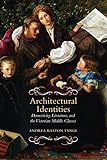Architectural Identities : Domesticity, Literature and the Victorian Middle Class / Andrea Kaston Tange.
Material type: TextPublisher: Toronto : University of Toronto Press, [2010]Copyright date: ©2010Description: 1 online resource (336 p.)Content type:
TextPublisher: Toronto : University of Toronto Press, [2010]Copyright date: ©2010Description: 1 online resource (336 p.)Content type: - 9781442641136
- 9781442686649
- 728.094209034 22
- online - DeGruyter
| Item type | Current library | Call number | URL | Status | Notes | Barcode | |
|---|---|---|---|---|---|---|---|
 eBook
eBook
|
Biblioteca "Angelicum" Pont. Univ. S.Tommaso d'Aquino Nuvola online | online - DeGruyter (Browse shelf(Opens below)) | Online access | Not for loan (Accesso limitato) | Accesso per gli utenti autorizzati / Access for authorized users | (dgr)9781442686649 |
Browsing Biblioteca "Angelicum" Pont. Univ. S.Tommaso d'Aquino shelves, Shelving location: Nuvola online Close shelf browser (Hides shelf browser)

|

|

|

|

|

|

|
||
| online - DeGruyter Fields of Play : An Ethnography of Children's Sports / | online - DeGruyter The Last Plague : Spanish Influenza and the Politics of Public Health in Canada / | online - DeGruyter Multiple Account Benefit-Cost Analysis : A Practical Guide for the Systematic Evaluation of Project and Policy Alternatives / | online - DeGruyter Architectural Identities : Domesticity, Literature and the Victorian Middle Class / | online - DeGruyter The Defining Decade : Identity, Politics, and the Canadian Jewish Community in the 1960s / | online - DeGruyter Atom Egoyan's 'The Adjuster' / | online - DeGruyter Ovid in the Age of Cervantes / |
Frontmatter -- Contents -- Acknowledgments -- Illustrations -- 1 Domestic Boundaries: The Character of Middle-Class Architecture -- 2 Redesigning Femininity: Expanding the Limits of the Drawing Room -- 3 Accommodating Masculinity: Staging Manhood in the Dining Room -- 4 Boundaries in Flux: The Liminal Spaces of Middle-Class Femininity -- 5 Fictions of Family Life: Building Class Position in the Nursery -- Coda: Remodelling the Architecture of Identity -- Notes -- Works Cited -- Index
restricted access online access with authorization star
http://purl.org/coar/access_right/c_16ec
Architectural Identities links Victorian constructions of middle-class identity with domestic architecture. In close readings of a wide range of texts, including fiction, autobiography, housekeeping manuals, architectural guides and floor plans, Andrea Kaston Tange argues that the tensions at the root of middle-class self-definition were built into the very homes that people occupied.Individual chapters examine the essential identities associated with particular domestic spaces, such as the dining room and masculinity, the drawing room and femininity, and the nursery and childhood. Autobiographical materials by Frances Hodgson Burnett, Thomas and Jane Welsh Carlyle, Elizabeth Gaskell, and Linley and Marion Sambourne offer useful counterpoints to the evidence assembled from fiction, demonstrating how and where members of the middle classes remodelled the boundaries of social categories to suit their particular needs. Including analyses of both canonical and lesser-known Victorian authors, Architectural Identities connects the physical construction of the home with the symbolic construction of middle-class identities.
Mode of access: Internet via World Wide Web.
In English.
Description based on online resource; title from PDF title page (publisher's Web site, viewed 01. Dez 2023)


